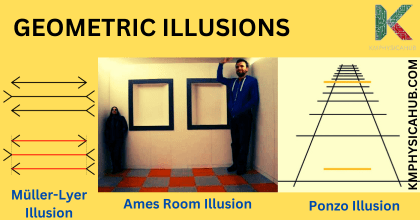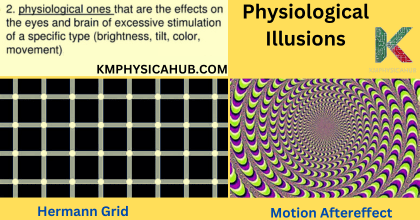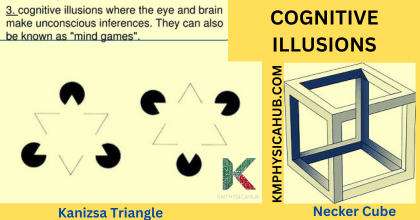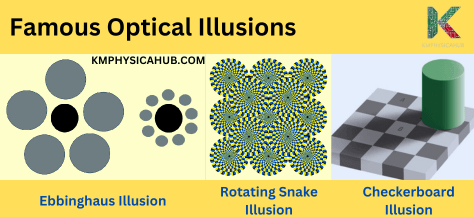Geometric, Physiological and Cognitive Illusions with Examples
What is Optical Illusion?
Optical illusions, or visual illusions, are amazing tricks that affect how we perceive objects and images which are not actually present or are quite different from what the illusion depicts in front of our eyes. They take advantage of how our eyes work and other heuristic processes that the brain uses to create low processing power shortcuts which then cause illusions, misconceptions and in some cases even misconceptions of the actual state of the world.
The Power of Perception:
Sensory perception can be defined as a process or a mechanism by which humans are able to perceive stimuli from the environment through organs of sense such as the eyes, ears or skin among others and interpret them comprehensively and distinctively. Our organs certainly provide input from the outside world, and yet it is our mind that decode all of this and create our individual perspective of reality. It is fascinating to consider what optical illusions show is the brain’s ability to influence the information which is given to the senses and it often distorts reality.
Brief History of Optical Illusions:
The dream for optical illusions can be traced back to prehistoric years. Some of the first reliefs and frescoes were discovered in prehistoric cave paintings where artists used geometric shapes to create a three-dimensional depth. During the renaissance, great artists such as Leonardo da Vinci, and Albrecht Durer sought to understand perspective, and the way images could be rendered to look real. Optical illusions have been addressed scientifically in the 19th century involving the scientists like Hermann von Helmholtz and Ewald Hering, who employed the methods of physiological and psychological analysis.
Types of Optical Illusions
Geometric Illusion, Examples and Mechanisms
The geometric optical illusions cause the sizes, shapes, and angles to appear distorted, generally taking advantage of depth cues and perspective. These illusions show that even though our brain tries to make order out of mess and interpret what we are observing we may easily be misled.
Definition:
The geometric optical illusions are based on incorrect interpretation of geometric shapes and lines, which are due to the profound issue of depth cues and perspective.
Examples:
-
Müller-Lyer Illusion:
This is one of the most famous optical illusions where although both lines are of the same length the one on the right looks longer than the one on the left because one of the lines has arrowheads that is facing to the opposite direction of the other line. The illusion happens due to our misperception where if the lines are drawn with arrowheads pointing inward then it gives an impression that the lines are further apart from each other and thus gives a longer look.
-
Ponzo Illusion:
This particular illusion consists of two straight lines of real length placed midway between two other parallel straight lines which are arranged to give the effect of perspective. If the position of the line is slightly lower along converging lines, then the line seems longer despite being the same size as the upper one. This illusion occurs due to the perceptions from the brain indicating that the converging lines are a sign of depth, and hence making objects that are farther appear larger than they actually are.
-
Ames Room:
This is an optical illusion of a distorted room aimed at giving the viewer different perceptions of size. Sloping walls and distorted floor of the room give an impression that people who stand in various parts of the room are of considerably different size, while in fact they are of equal height.

Mechanisms:
Perspective: The depth and distance perception is estimated with perspective cues including converging lines and relative size. Such cues are used in geometric illusions and thus lead to a wrong perception of size and shape.
Contrast: Another perspective is that just a position of lines and shapes can also play the noticing game with us. In the Müller-Lyer illusion, the inward-facing arrowheads are darker and stand out more contrastingly against the background space, therefore giving the appearance of a longer line.
Depth Cues: The perceived depth refers to the depth information that our visual system computes, which includes binocular disparity, linear perspective and occlusion. In fact, the geometric illusions are specifically built upon these cues, which then result in the distortion of size and shape perception.
Physiological Illusion, Examples and Mechanisms
Physiological illusions make use of imperfections of visual sensory organ, therefore, creating disorders in color, luminance and movement. Such illusions can be caused by sensory adaptation, retinal fatigue or the neural mechanisms which helps the brain to interpret the flow of input from the eyes.
Definition:
Physiological illusions are caused by the design of our eyes or the way through which our brains interpret what we see, which in most cases leads to some distortion in color, brightness, or motion.
Examples:
-
Hermann Grid:
This illusion is a grid containing black squares of varying sizes with white spaces between them. Between the squares, we can see gray points although they are not clearly seen as if they are not there at all. It stems from the manner through which our vision system perceives edges and different levels of contrast which brings into play the lateral inhibition effect.
-
Afterimage Effect:
This is best explained when after gazing at a bright color for sometime, upon looking at a neutral surface, one gets to see a negative of that color. For instance, if one looks at a red square, he or she is likely to have a green afterimage following this event. This illusion takes place because, after some time, the photoreceptor cells in the retina are less sensible to the color to which they have been exposed.
-
Motion Aftereffect:
After observing an object in motion for some duration one will start perceiving another object that was stationary to be moving in the opposite direction. This apparent motion is due to the adaptation of neurons in the visual cortex that make signals for movement.

Mechanisms:
Sensory Adaptation: If there is continuous exposure to certain stimuli or light, our senses become insensitive to them. This adaptation can result in optical illusions such as the after image illusion where our eyes become less sensitive to a particular color.
Retinal Fatigue: The ability to distinguish far objects may be affected due to the fatigue of the photoreceptor cells in the retina by continued exposure to specific colors or patterns. This fatigue contributes towards the production of the afterimage effect.
Neural Processing: Perception of images is intricate within our brain and the process of perceiving images sometimes results in creating an illusion. For example, the Hermann grid illusion results from the incorrect neural processing of edges and contrast, giving the observer the sensory impression of gray dots at the intersections.
Cognitive Illusion, Examples and Mechanisms
Its true that cognitive illusions occur as a result of the brain trying to make sense of things that are not very clear or make complete sense. They are based mostly on the prejudgments, presumptions, and self-conceptions which are inherent in the perception process.
Definition:
Cognitive illusions stem from schemes to interpret and explain such stimuli that are partly defined or even vague, with the process often being colored by expectations, assumptions or biases.
Examples:
Kanizsa Triangle:
This illusion includes three circles that are drawn halfway, each of which has a ‘pac-man’ shape and are positioned such that the missing portions form a triangular pattern. We become aware of a white triangle, though the figure is not there physically. This piece of illusion is formed due to the way our brains work and particularly how they tend to predict missing information to complete the existing shapes.
Necker Cube:
This illusion depicts a two dimensional cube that can only be seen in two ways and the front face of the cube is interchanged with the top or bottom. The trick is that the drawing itself is not completely clear and you can see it in different perspectives.

Mechanisms:
Top-Down Processing: Cognitive illusions are usually excellent examples of how the top-down processing works because they rely on prior knowledge and expectations about what is being seen. This top-down processing is what our brains use in making sense of the environment but it is not free from such mistakes in perception.
Pattern Recognition: Neurons in our brains are programmed to identify some sort of pattern, and this leads to illusions where patterns are seen even when they do not exist. Kanizsa triangle is a good example where people are able to see a triangle from incomplete circles.
Perceptual Ambiguity: Cognitive illusions often arise from the ambiguity of the visual information, allowing our brains to interpret it in multiple ways. The Necker cube is a prime example of this, where the drawing can be interpreted as two different cubes depending on how our brains organize the lines.
How Optical Illusions Work
The Visual System:
Perceptual Ambiguity: Cognitive illusions often arise from the ambiguity of the visual information, allowing our brains to interpret it in multiple ways. The Necker cube is a prime example of this, where the drawing can be interpreted as two different cubes depending on how our brains organize the lines.
Perception and Reality:
Optical illusions describe the difference between the appearance of things as received through the sense of sight and their actual appearance in the real sense. In other words, perception is what the brain infers about the environment and generated through the accumulated input from our senses. Whereas reality may be described as an existence in the real world beyond one’s personal representation of it. Optical illusions show that perception differs greatly from reality, which shows the limitations of the visual system.
The Role of Context:
Our understanding of the visual information is always based on our prior knowledge and the atmosphere of the surrounding environment. It can influence our perception of size, shape, color, even motion, depending on the context people are in. For instance, a small figure may seem larger than it actually is due to objects in its environment being small. A straight line, due to being surrounded by curved lines, may seem curved itself.
The Brain’s Shortcuts:
Our brains work in a way that enables fast and tedious information processing utilizing mental subprograms and a set of rules referred to as heuristics. Although these shortcuts are useful, they cause perceptual errors in some cases due to the early filtering of some ambiguous or incomplete information. These shortcuts are used by optical illusions in order to show that the perceiving apparatus is not accurate.
Examples of Famous Optical Illusions
The Rotating Snake Illusion:
This is a straightforward optical illusion of spiraling lines that seem to move in a circle even though the picture is stationary. Eye trickery well manifests itself in the way how our brain perceives the edges and curves of the spiral and they give an impression of movement. The illusion is particularly effective since it interacts with the neuron groups that are responsive to actual movement.
The Checkerboard Illusion:
This illusion, which was named the “Adelson Checkerboard,” comprises a checkerboard with the squares painted in shades of gray. For one to be deceived, he or she is likely to perceive shadows as a variety of shades of gray even though they may in fact be the same shade. Our brains try to make an estimate due to the tendency of self- formation and put more darkness in the squares, which are still in the shadow.
The Ebbinghaus Illusion:
This illusion involves two circles of the same diameter. However, one circle seems bigger than the other since enclosed in bigger circles. Circle with small circles around it seems bigger while circle with large circles around it seems smaller. This is because perception depends on the relative comparisons made in our minds with respect to the objects’ context.
The Café Wall Illusion:
This illusion consists of an arrangement of regularly interchanged colored blocks, where the horizontal lines appear to be uneven due to this illusion. This illusion occurs due to a misinterpretation of the horizontal lines based on the manner the brain perceives colors and contrasts.

Applications of Optical Illusions
Art and Design:
Designers and artists have been using optical illusions in their work to ensure that the visuals drawn are optimal. By changing the point of view, hues, and shadows, some artists draw shapes that are impossible in reality, but seem correct in their pictures.
Perspective: Leonardo da Vanci and the other Renaissance artists used perspective methods to paint objects in 3D on a flat surface.
Color and Light: Artists employ contrast of color and shading to depict perceived perception of depth.
Entertainment:
Optical illusions are very popular in entertainment due to their ability to deliver highly engaging experiences.
Movies and Video Games: Illusion techniques are employed in order to establish real special effects like setting up the depth of the field in two dimensional space and dynamics of perspectives to develop the sense of scale.
Theme Parks: Usually, the theme parks employ the use of illusions in matters such as making the buildings look larger or even smaller than they really are.
Scientific Research:
Optical illusions are useful in determining the brain’s capacity and the possibilities of its visual pathways.
Brain Function: Scientists utilize illusions to determine regions of the brain that control visual functions.
Perception and Cognition: Optical illusions can be seen as a clue for understanding the functioning of perception, attention, and decision-making revealing the defects of the visual system and the distortion of perception by certain heuristics.
Everyday Life:
It is important to note that optical illusions do not just exist in works of art, entertainment and scientific exploration of various phenomenon. They are part of our daily reality, affecting how we interact with objects, spaces and even our own physical selves.
Shadows and Reflections: Shadows and reflections are also capable of giving an illusion of depth and movement like in how a shadow will give an impression that the object behind it is moving while a reflection will give impression of a double image.
Visual Illusions in Clothing and Fashion: Optical illusions in fashion designing are employed with the purpose of suggesting the possibilities of slimming down, and hence modifying the shape of the human body.
Conclusion:
People are always interested in optical illusions since they make us rethink the concept of reality. They also form a pleasing visual experience, and depict the richness of the human mind.
This field of physics is still growing. Improvements in computer graphics, VR, and AR technologies imply that there are more opportunities to make new, even more convincing optical illusions. Such innovations have the capability to transform and alter the way individuals perceive art, design, and entertainment.
Optical illusions point out that what we see is absolutely dependent on the way our brains have been wired. It underlines the need to think critically and constantly ask questions regarding given information and ideas. Through comprehending how illusions can be created and used, one can better comprehend the intricacies of the human mind and how it functions.
FAQs
Q: Can optical illusions make you feel physically different?
A: Dizziness, motion sickness, or even the sensation of floating above the ground can be caused due to exposure to some illusions. For instance, the “rubber hand illusion” is an experiment where your brain is fooled into thinking that the fake hand is its own.
Q: Can some people be more sensitive to the optical illusions?
A: Yes, things like the age or type of personality that the person has can play role in this as well as cultural differences. For example, Young children have stronger illusion perception than adults.
Q: What are the types of optical illusions?
A: Optical illusions have following three types:
- Geometric illusion(size, shape, angles)
- Physiological illusion(light, color, motion)
- Cognitive illusion(interpretation of ambiguous information).
Q: Is optical illusion a sign of problem with the vision?
A: No, everyone experiences optical illusions. They are normal and demonstrate the fascinating complexity of our brains.